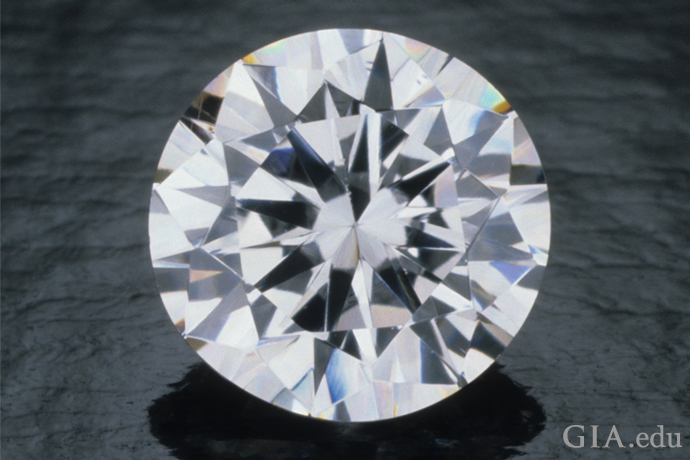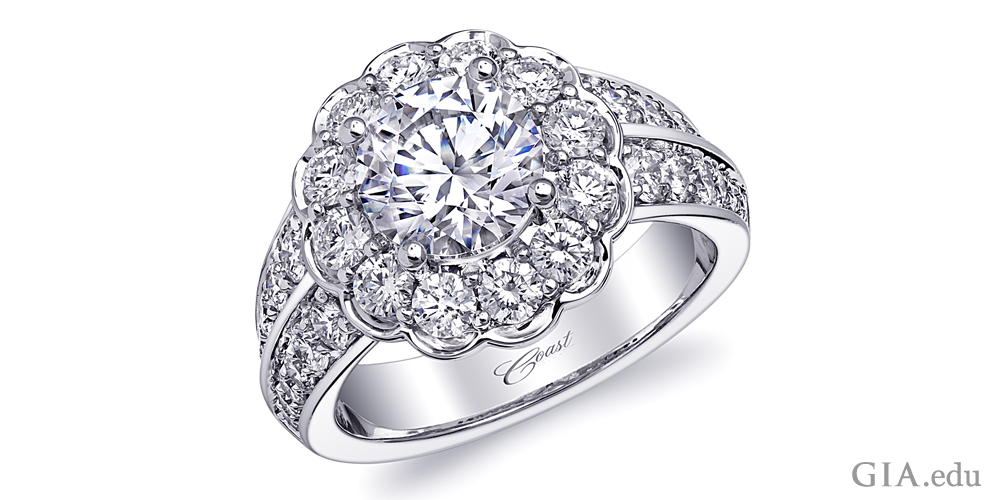Simulated diamonds — or diamond simulants — may look like diamonds, but they don’t have the same chemical, physical and optical properties. If you’re shopping for a diamond imitation, make sure you know the unique characteristics of the stone you are getting.
What materials are used as diamond simulants?
Both laboratory-grown gems (also called “synthetic” gems) and natural gems that look like a particular gem can be used to imitate that gem. Gemologists call these imitations “simulants.” Natural materials, such as colorless quartz, topaz, sapphire, beryl and especially zircon, have been used as diamond simulants for centuries.
Many of the most popular diamond simulants today, such as cubic zirconia and moissanite, are synthetic stones manufactured in laboratories. Cubic zirconia, for example, is made by heating powdered ingredients to their melting point and then cooling the mixture to a solid state.
IMPORTANT TIP: Diamond simulants are not the same as laboratory-grown (or lab-created) diamonds. Lab-grown diamonds have the same chemical, physical and optical properties as natural diamonds, while simulants do not. Read more about lab-grown diamonds.

This 14K rose gold ring is set with a near-colorless round brilliant synthetic moissanite, a popular diamond simulant introduced in the late 1990s. Courtesy: Brilliant Earth.
How Do Simulated Diamonds Compare to Diamonds?
Each simulant has unique properties, so it is difficult to compare simulants to diamonds as a whole. Overall though, diamond is harder than any simulant. The Mohs Scale rates the hardness of gems and minerals. Diamond — a 10 — is at the top, making it one of the hardest natural substances on earth. This means that most diamonds will hold up to daily wear and tear, while many simulants might soon develop scratches and visible abrasions, especially along facet junctions. Also, because of their superior hardness, diamonds can take a better polish than other gems or simulants. This means diamonds have a brighter luster than most simulants.
Another factor to pay attention to is that simulants have varying densities (weight to volume ratio). This means that simulants with greater density than diamond (such as GGG) might appear smaller than diamonds of the same carat weight, while a stone with less density than diamond might appear larger.
Finally, while diamond has more fire than most simulants, a few simulants, such as synthetic moissanite and synthetic rutile, have more fire than diamond. Some people appreciate the intensity of these simulants’ fire while others think that the excessive fire draws attention to the fact that the stone is “different” and not a diamond.
Diamond Simulants: Pros and Cons
If you’re considering a diamond simulant, read our breakdown of the most popular diamond simulants and their plusses and minuses. All can be safely cleaned with warm soapy water, but some may react differently to other common cleaning methods.
| Cubic Zirconia (CZ) | |
|---|---|
 Copyright: GIA & Tino Hammid |
Materials:Cubic zirconia (CZ) Care & Cleaning: |
Pros:CZ is very affordable. It has good hardness (8.5) and is often colorless and flawless. It has slightly greater fire than diamond. |
Cons:CZ scratches more easily than diamond and has less brilliance. Some people think that its broad flashes of color look “artificial.” Colorless CZ may yellow over time. |
| Synthetic Moissanite | |
|---|---|
 Photo: Robert Weldon/GIA. |
Materials:Synthetic moissanite Care & Cleaning: |
Pros:It’s the hardest of all the diamond simulants and has more than twice the fire of diamond. It can also be colorless to nearly colorless with high clarity. It is less likely to attract grease than diamond. |
Cons:It is doubly refractive and may appear slightly fuzzy in some directions because of the doubling of its back facets. In large sizes, its extreme fire may make it appear “artificial” and give it away as a simulant and not a diamond. |
| Zircon | |
|---|---|
Materials:Zircon Care & Cleaning: |
|
Pros:A natural stone, zircon is the oldest stone on earth. It has fire close to that of diamond. |
Cons:Zircon is not a very hard or durable stone. It can be rather brittle, so care should be taken when wearing it as a ring stone. It is also doubly refractive, meaning that you will see a double image of its facets when you look into the stone. This may make the stone appear blurry. |
| Sapphire, Colorless | |
|---|---|
|
Synthetic  Near-colorless synthetic sapphire. |
|
Materials:Sapphire, colorless |
Care & Cleaning:Ultrasonic: Usually safe |
Pros:Colorless sapphire is both hard and tough, so it’s extremely durable and can be worn as a ring stone. Natural colorless sapphire is a relatively affordable gem if you’re looking for a natural stone. |
Cons:Colorless sapphire is not nearly as bright or fiery as diamond and requires frequent cleaning to keep it looking its best. Truly colorless natural sapphires are rare. Most colorless sapphires are usually just near-colorless. |
| Synthetic Rutile | |
|---|---|
 Copyright: GIA & Tino Hammid |
Materials:Synthetic Rutile Care & Cleaning: |
Pros:Synthetic rutile is slightly more brilliant than diamond and has more than seven times the fire of diamond. |
Cons:Because of synthetic rutile’s low hardness, it scratches fairly easily and typically has rounded facet junctions. It is doubly refractive, meaning that you will see a double image of its facets, which may make the inside of the stone appear blurry. Synthetic rutile is also often slightly yellowish, and its intense, “psychedelic” fire easily gives it away as a non-diamond stone. |
| Gadolinium Gallium Garnet (GGG) | |
|---|---|
 Copyright: GIA & Tino Hammid |
Materials:Gadolinium gallium garnet (GGG) Care & Cleaning: |
Pros:GGG has similar fire as diamond. It is often colorless. |
Cons:Because of its low hardness, GGG scratches fairly easily and typically has rounded facet junctions. It has roughly twice the density of diamond, so it will be smaller than diamond for the same carat size. It is no longer much used as a diamond simulant and is typically only found in vintage jewelry. |
| Yttrium Aluminum Garnet (YAG) | |
|---|---|
 Photo: Robert Weldon/GIA. |
Materials:Yttrium aluminum garnet (YAG) Care & Cleaning: |
Pros:YAG has good hardness and high clarity. |
Cons:It lacks the distinct fire and luster of diamond. It is no longer much used as a diamond simulant and is typically only found in vintage jewelry. |

An edgy take on the classic engagement ring, Selda Okutan’s “A Drop of Tear” ring features a colorless zircon set in oxidized sterling silver. Courtesy: Selda Okutan
Should I Buy a Diamond Simulant?
There are many factors to consider when deciding between diamonds and diamond simulants. People typically consider buying diamond simulants because diamond simulants are more affordable than diamonds of similar size, color and clarity.
But are they worth it? That depends on how open you are to the unique characteristics of each simulant. No simulant is as hard as diamond, but some are hard and durable enough to serve as ring stones for everyday wear. Many are not as brilliant or fiery as diamond, but a few actually have more fire than diamond. Ultimately, whether a simulant has less fire and brilliance or more, you should see it in person to see if its unique sparkle and fire suit your taste.
Another consideration is the origin story of the stone. Natural diamonds were formed by nature millions to billions of years ago, deep within the earth and shot to the surface by volcanoes, something that cannot be said of lab-grown simulants or lab-grown diamonds. The origin story of natural diamonds can add to the sentimental value of jewelry, especially when it is destined to become a family heirloom. Natural diamonds will also retain more value than diamond simulants. But if you’re looking for an affordable, attractive alternative, a diamond simulant might just be the way to go!

This platinum engagement ring features a 1.50 ct CZ center stone and is surrounded by 1.40 carats of diamonds. Some wearers call these rings placeholder rings and may choose to swap the CZ for a diamond at a later date. Courtesy: Coast Diamond
Whichever material you choose, make sure the seller accurately informs you about its identity and durability, since these affect the stone’s price and long-term care. Whether the stone is a diamond or a diamond simulant, it will shine longer with proper care and cleaning. If you’re uncertain about the identity of a stone that you own or are thinking of purchasing, you can always submit the stone to a GIA laboratory for a grading report.
Recommended for you: wondering how to tell if a diamond is real?




